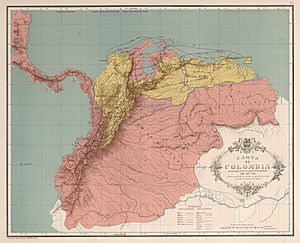Magdalena campaign facts for kids
Quick facts for kids The Magdalena campaign |
|||||||
|---|---|---|---|---|---|---|---|
| Part of Spanish American wars of independence | |||||||
 Conflicts in New Grenada, 1806–1814. |
|||||||
|
|||||||
| Belligerents | |||||||
| Commanders and leaders | |||||||
| Simón Bolívar, Pierre Labatut | Aguardole Rebustillo | ||||||
The Magdalena campaign was a series of battles in late 1812 and early 1813. It was led by Simón Bolívar and Pierre Labatut, who were fighting for independence. They fought against the royalists, who supported the crown of Spain, in a place called New Granada (which is now Colombia). The main goal was to gain control of the Magdalena River. This river was very important because it connected the port city of Cartagena with the rest of Colombia. After the campaign, the independent forces, known as the United Provinces of New Grenada, took control of this vital waterway.
Contents
Why the Campaign Started
In April 1812, the First Republic of Venezuela fell apart. Spanish forces, led by Domingo de Monteverde, took control again. Because of this, many people who wanted independence, including Simón Bolívar, had to leave Venezuela. They found safety in Cartagena.
Cartagena's Independence
Cartagena had declared its independence on November 11, 1811. It became a strong base for the independence movement. A nearby city, Santa Marta, had also tried to become independent in August 1810. However, its leaders were removed just a few months later. This led to a long war between the royalists in Santa Marta and the independent forces in Cartagena.
Royalist Uprisings
In September 1812, some communities in Cartagena Province rebelled. These were local people in areas like Corozal and Tolú. Local priests encouraged these uprisings. Cartagena also needed a lot of supplies, which made people in the countryside unhappy. The royalists used this anger to their advantage.
They knew that many local people did not like the idea of a liberal revolution. These people worried about losing their traditional rights. So, the royalists were able to block traffic on the Magdalena River. This was a big problem for Cartagena, as the city relied on the river for supplies. Cartagena became cut off, surrounded by royalist troops. These royalist forces were getting supplies from Cuba.
The Cartagena Manifesto
Simón Bolívar and other leaders wanted to plan a new fight to take back Venezuela. On December 15, 1812, they wrote a document called the Cartagena Manifesto. This paper explained why the First Republic of Venezuela had failed. It also warned the United Provinces of New Granada not to make the same mistakes. These mistakes included too much federalism (local power), strong religious beliefs, and fighting among political groups.
How the Campaign Unfolded
After arriving in Cartagena, Bolívar asked to join the city's army. He was given command of a small group of 70 men in the town of Barrancas. Bolívar was initially under the command of a French soldier named Pierre Labatut.
Royalist Preparations
The royalists from Santa Marta planned to attack Cartagena. They gathered about 1,500 soldiers along the Magdalena River. Their first target was Mompox. The people of Mompox fought back, but the royalists won. They took Mompox, along with Guamal, Valledupar, and Riohacha.
Meanwhile, many independent fighters from Venezuela joined a Spanish colonel named Manuel Cortés de Campomanes. He moved down the Magdalena River with 600 men. However, royalist groups led by Aguardole Rebustillo ambushed them. This happened where the Mancomaján River meets the Magdalena. Two days later, they fought again in the village of Oveja. The independent forces won both battles. Rebustillo escaped back to Santa Marta. Cortés de Campomanes then focused on stopping other royalist uprisings nearby.
Bolívar's Actions
Bolívar decided to act without waiting for Labatut's orders. He attacked the royalists who were gathering supplies in villages along the Magdalena River. He successfully drove them out of Tenerife, Guamal, El Blanco, Mompós, Tamalameque, and the port of Ocaña. He also defeated several royalist groups in the area. Finally, he captured the city of Ocaña on January 10, 1813. The fighting in Bolívar's part of the campaign was not very intense, and there were few casualties.
Labatut's Actions
Labatut started his own part of the campaign. He had 200 independent fighters from Barranquilla and several small boats. In early November, they captured the forts at Sitio Nuevo, El Palmar, and Sitio Viejo. They took 16 cannons and 4 armed boats. Labatut then attacked Gúaimaro on November 18 with 340 soldiers. He captured many cannons, ammunition, and armed boats. The French commander stayed to take control of the local government. He also cleared out any remaining royalists hiding in the San Antonio hills. After these victories, the lower Magdalena River region was under the control of the independent forces. This control lasted until the Spanish reconquest of New Granada in 1815.
What Happened Next
After the success of the Magdalena campaign, Bolívar began planning his next big move. This was the Campaña Admirable, which aimed to retake Venezuela. He left his troops in the care of Manuel del Castillo y Rada.
See also
 In Spanish: Campaña del Magdalena para niños
In Spanish: Campaña del Magdalena para niños
- Campaña Admirable

